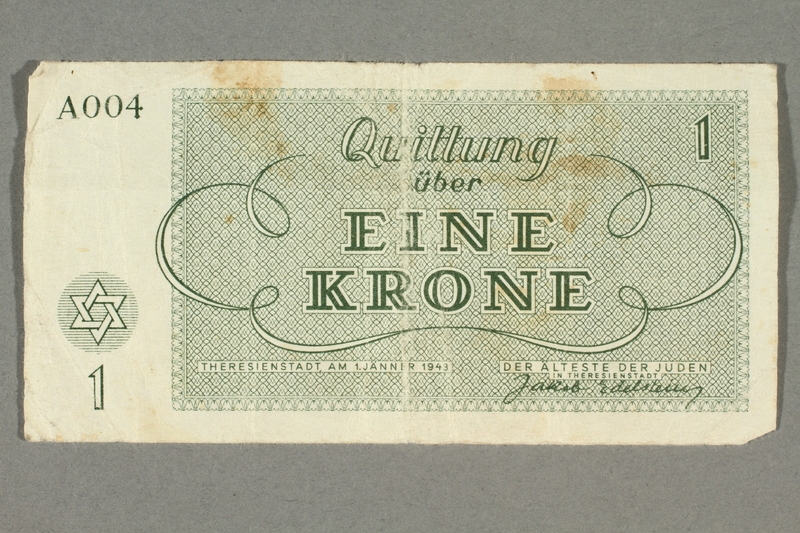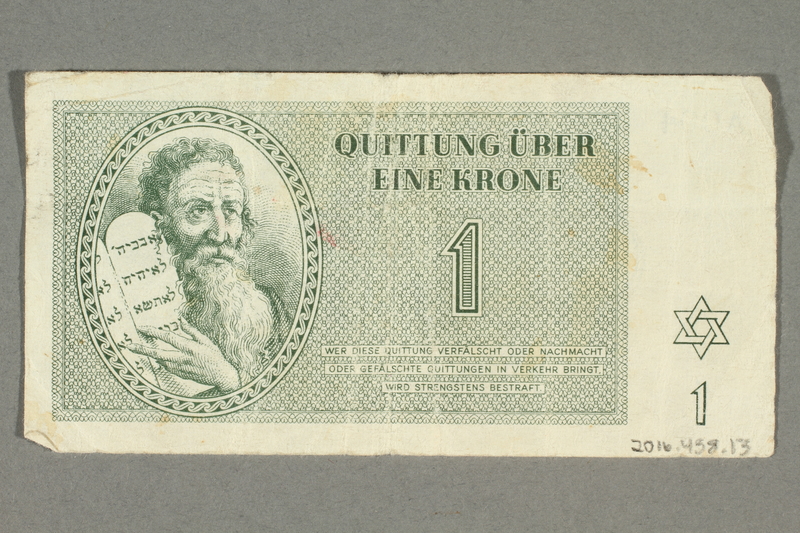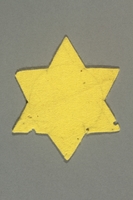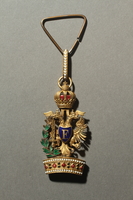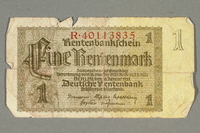Overview
- Brief Narrative
- Scrip, valued at 1 (eine) krone, of the type distributed in Theresienstadt (Terezin) ghetto-labor camp beginning in May 1943. The ghetto currency was printed by the National Bank in 7 denominations: 1, 2, 5, 10, 20, 50, 100. Inmates were not allowed to have currency, which was confiscated. The SS ordered the Jewish Council to design scrip for use only in the camp. It was issued to create a false appearance of normalcy. There was little to obtain with the scrip. Located thirty miles northwest of Prague in German occupied Czechoslovakia, the camp was established by the Germans in November 24, 1941, and ceased operation in early May 1945. In 3.5 years, approximately 140,000 Jewish persons were transferred to Terezin; nearly 90,000 were then deported, likely to their death, further east. About 33,000 died in Theresienstadt.
- Date
-
issue:
1943 January 01
- Geography
-
issue:
Theresienstadt (Concentration camp);
Terezin (Ustecky kraj, Czech Republic)
- Credit Line
- United States Holocaust Memorial Museum Collection, Gift of Barbara Adler
- Markings
- front, lower center, green ink : WER DIESE QUITTUNG VERFÄLSCHT ODER NACHMACHT / ODER GEFÄLSCHTE QUITTUNGEN IN VERKEHR BRINGT. / WIRD STRENGSTENS BESTRAFT [ANYONE WHO FALSIFIES OR DISTORTS OR FAKES THIS RECEIPT, OR COUNTERFEITS RECEIPT, WILL BE STRICTLY PUNISHED]
front, lower right corner, green ink : 1
reverse, upper left corner, plate letter and number, green ink :
reverse, center, green ink : Quittung / über / EINE KRONE [Receipt / of / ONE CROWN]
reverse, lower left and upper right corner, green ink : 1
reverse, lower center, green ink : THERESIENSTADT, AM 1.JANNER 1943 DER ALTESTE DER JUDEN / IN THERESIENSTADT / Jakob Edelstein [THERESIENSTADT, ON 1. JANUARY 1943 THE ELDER OF THE JEWS IN THERESIENSTADT / Jakob Edelstein] - Contributor
-
Printer:
National Bank of Prague
Designer: Peter Kien
Issuer: Der Alteste der Juden in Theresienstadt
- Biography
-
Franz Peter Kien was born January 1, 1919, in Varnsdorf, Czechoslovakia (Czech Republic), to Leonard and Olga Frankl Kien. His father Leonard was born in 1886, in Varnsdorf, and was a member of the German-speaking Jewish population in the, the Sudetenalnd, which bordered Germany. Leonard was a textile manufacturer with his own factory. Peter’s mother Olga was born in 1898, in Bzenec, Austro-Hungary (Czech Republic), to Jewish parents. After 1929, the Kien family moved to Brno. Peter enrolled at the German Gymnasium, where he excelled at drawing, painting, and writing. In 1936, he graduated and moved to Prague to study at the Academy of Fine Arts. He also attended the Officina Pragensis, a private graphic design school run by a well-known Jewish artist, Hugo Steiner-Prag.
On September 29, 1938, Germany annexed the Sudetenland. On March 15, 1939, Germany invaded Prague and annexed the Bohemia and Moravia provinces of Czechoslovakia, ruled by a Reich Protector. Jews were banned from participation in government, businesses, and organization, including schools. Peter had to leave the Academy, but continued to study at the Officina Pragensis. He also taught at Vinohrady Synagogue. In September 1940, Peter married Ilse Stranska, who was born on May 9, 1915, in Pilsen, to Jewish parents.
In late September 1941, Reinhard Heydrich, the SS head of RSHA, Reich Main Security Office, became Reich Protector. Soon there were regular deportations of Jews to concentration camps. At the end of November, Theresienstadt concentration and transit camp near Prague got its first shipment of Jewish prisoners. On December 14, Peter was transported to Theresienstadt ghetto-labor camp. He was assigned to the technical department where he worked as a draftsman and designer alongside other artists, including Bedrich Fritta, Leo Haas, and Jiri Lauscher. On July 16, 1942, Peter’s wife Ilse arrived in the camp. On January 30, 1943, Peter’s parents Leonard and Olga were transported from Bzenec to Terezin. Peter was assigned major projects by the Jewish Council that administered the camp for the Germans, such as the scrip receipts used in place of money in the camp. He secretly documented the inmate’s daily life, creating portraits and other drawings, and wrote plays, poems, and an operatic libretto. On October 16, 1944, Peter’s wife Ilse and his parents Leonard and Olga were selected for deportation. Peter volunteered to go with them. Before leaving, Peter and his family were sent to Auschwitz concentration camp in German-occupied Poland. Peter survived the selection process, soon fell ill, likely with typhus, and died at age 25 in late October 1944. His wife and parents were killed at Auschwitz. Some of the work that Peter left with other prisoners or hid at Theresienstadt survived and has been exhibited worldwide.
Physical Details
- Language
- German
- Classification
-
Exchange Media
- Category
-
Money
- Object Type
-
Scrip (aat)
- Physical Description
- Theresienstadt scrip printed on rectangular offwhite paper in black and green ink. The face has a vignette of Moses, with a long beard and wrinkled brow, holding 2 stone tablets with the 10 Commandments in Hebrew. To the right is the denomination 1 and German text. The background rectangle has an intricate latticework pattern. The right side has a wide offwhite margin with the denomination 1 below a Star of David. The reverse has a background rectangle of interlocked squares, overprinted with German text, an engraved signature, and a large scrollwork line. The denomination 1 is in the upper right corner. The left side has a wide, offwhite border with 1 below a Star of David within a lined circle. The plate letter and number are in the upper corner.
- Dimensions
- overall: Height: 2.000 inches (5.08 cm) | Width: 4.000 inches (10.16 cm)
- Materials
- overall : paper, ink
Rights & Restrictions
- Conditions on Access
- No restrictions on access
Keywords & Subjects
Administrative Notes
- Legal Status
- Permanent Collection
- Provenance
- The scrip was donated to the United States Holocaust Memorial Museum in 2016 by Barbara S. Adler.
- Funding Note
- The cataloging of this artifact has been supported by a grant from the Conference on Jewish Material Claims Against Germany.
- Record last modified:
- 2022-07-28 18:13:43
- This page:
- https://collections.ushmm.org/search/catalog/irn543618
Also in Denes and Janos Adler family collection
The collection consists of a World War I medal, scrip and currency, a Star of David badge, a tablecloth, albums, correspondence, documents, photographs, and a publication related to the experience of brothers Denes and Janos Adler, originally of Szeged, Hungary, and members of their extended families, as well as the family of Eva Timar Adler before, during, and after the Holocaust, when Denes emigrated before the war and Eva and Janos survived forced labor camps and emigrated to the United States following the war.
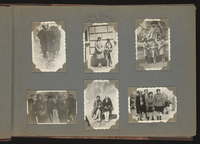
Adler family papers
Document
The Adler family papers document the Holocaust experiences of brothers Denis and János Adler, originally of Szeged, Hungary, and members of their extended families. The collection contains correspondence, biographical materials, immigration documents, restitution claims, and photographs regarding pre-war family lives; Denis’s emigration from Szeged in 1939; János’s conscription into the Hungarian Labor Service that accompanied German troops during the invasion of the Soviet Union, and his subsequent wounding and imprisonment in the field hospital in Alexajewka-Nikolajewka; the imprisonment and forced labor of Eva Adler, her mother Berta Neumann, and Borsca Adler in the Strasshof labor camp, Bergen-Belsen concentration camp, and Theresienstadt concentration camp; and post-war immigration to the United States. The biographical materials primarily contain birth, marriage, and death certificates; identification documents such as passports; employment records; and school records and diplomas. Other materials include documents related to Denis Adler’s medical profession in Szeged, Paris, and Los Angeles; János Adler’s brief name change to János Arató in 1946; accounting sheets of Eva Adler that likely represent clothing she made and sold; and records for the sale of a family property in Szeged in 1947. In addition, there are documents regarding Eva Adler, Borsca Adler, and Berta Neumann’s imprisonment in Theresienstadt concentration camp, and their repatriation from there to Szeged in late 1945. The bulk of the correspondence consists of letters exchanged among family members from 1938-1945. Many of the letters were received by Denis Adler, Lisa Timár, and Gyula Neumann, all of whom had arrived in the United States by 1941. The correspondence of Denis Adler also includes letters received by his brother János discussing family news and the conditions in Szeged in the fall of 1945; and letters by Raymonde Grumbach and Francois Moutier, both of whom were doctors Denis worked with while in Paris. The correspondence of Lisa Timár includes letters from János and Eva in Szeged to Lisa, 1937-1941; and extensive letters from her stepfather Gyula Neumann. Other correspondence includes postcards exchanged between János and Eva after János was conscripted into the Hungarian Labor Service and sent to Kunszentmiklós. There is also post-war correspondence of János from his former school friends and his teacher Jozsef Kerkai. The emigration and immigration papers primarily document János, Eva, and Borsca Adler’s efforts to immigrate to the United States after the war. Included are application materials, travel documents, and correspondence. There is also correspondence between Denis Adler and the United States Department of State on behalf of his mother, Borsca. The restitution claims contain records relating to the Adler family’s restitution claims through the Foreign Claims Settlement Commission of the United States, and the Austrian Reconciliation Fund. Included are applications, supporting documents, and correspondence. The photographs primarily document the Adler and Timár families’ pre-war lives in Szeged, but also include some wartime photographs and post-war depictions of family life in Szeged and the United States. The pre-war photographs include childhood photographs of Eva, Lisa, Denis, and János; various related family members; Jewish social events attended by Eva and Lisa; and Denis’s medical school. Wartime photographs include Denis with other doctors in Paris, aboard the S.S. Winnipeg, and in custody in Trinidad in 1941 while en-route to the United States; Janós with Jewish labor troops, likely in Kiszomber and Makó; and probably French prisoners in Szeged and Haag, Austria. Post-war photographs include Janós and Eva’s apartment in Szeged and various family members in the United States. The ephemera include a cookbook from Bergen-Belsen that was owned by Eva Adler, a prayer book in Hungarian, and a collection of writings that were likely authored by Lisa Timár.
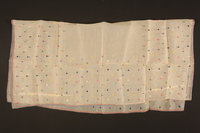
Embroidered tablecloth made in a forced labor camp
Object
Embroidered tablecloth made by Eva Timas in a forced labor camp in Hagg, Austria.
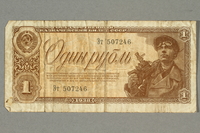
Soviet Union, one ruble note
Object
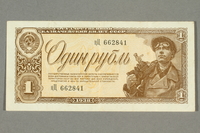
Soviet Union, one ruble note
Object
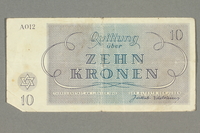
Theresienstadt ghetto-labor camp scrip, 10 kronen note
Object
Scrip, valued at 10 (zehn) kronen, of the type distributed in Theresienstadt (Terezin) ghetto-labor camp beginning in May 1943. The ghetto currency was printed by the National Bank in 7 denominations: 1, 2, 5, 10, 20, 50, 100. Inmates were not allowed to have currency, which was confiscated. The SS ordered the Jewish Council to design scrip for use only in the camp. It was issued to create a false appearance of normalcy. There was little to obtain with the scrip. Located thirty miles northwest of Prague in German occupied Czechoslovakia, the camp was established by the Germans in November 24, 1941, and ceased operation in early May 1945. In 3.5 years, approximately 140,000 Jewish persons were transferred to Terezin; nearly 90,000 were then deported, likely to their death, further east. About 33,000 died in Theresienstadt.
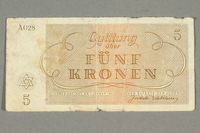
Theresienstadt ghetto-labor camp scrip, 5 kronen note
Object
Scrip, valued at 5 [funf] kronen, of the type distributed in Theresienstadt (Terezin) ghetto-labor camp beginning in May 1943. The ghetto currency was printed by the National Bank in 7 denominations: 1, 2, 5, 10, 20, 50, 100. Inmates were not allowed to have currency, which was confiscated. The SS ordered the Jewish Council to design scrip for use only in the camp, which was issued to create a false appearance of normalcy. There was little to obtain with the scrip. Located thirty miles northwest of Prague in German occupied Czechoslovakia, the camp was established by the Germans in November 24, 1941, and ceased operation in early May 1945. In 3.5 years, approximately 140,000 Jewish persons were transferred to Terezin; nearly 90,000 were then deported, likely to their death, further east. About 33,000 died in Theresienstadt.
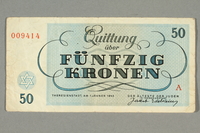
Theresienstadt ghetto-labor camp scrip, 50 kronen note
Object
Scrip, valued at 50 (funfzig) kronen, of the type distributed in Theresienstadt (Terezin) ghetto-labor camp beginning in May 1943. The ghetto currency was printed by the National Bank in 7 denominations: 1, 2, 5, 10, 20, 50, 100. Inmates were not allowed to have currency, which was confiscated. The SS ordered the Jewish Council to design scrip for use only in the camp, where it was issued to create a false appearance of normalcy. There was little to obtain with the scrip. Located thirty miles northwest of Prague in German occupied Czechoslovakia, the camp was established by the Germans in November 24, 1941, and ceased operation in early May 1945. In 3.5 years, approximately 140,000 Jewish persons were transferred to Terezin; nearly 90,000 were then deported, likely to their death, further east. About 33,000 died in Theresienstadt.
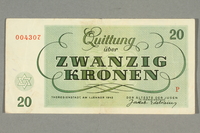
Theresienstadt ghetto-labor camp scrip, 20 kronen note
Object
Scrip, valued at 20 (zwanzig) kronen, of the type distributed in Theresienstadt (Terezin) ghetto-labor camp beginning in May 1943. The ghetto currency was printed by the National Bank in 7 denominations: 1, 2, 5, 10, 20, 50, 100. Inmates were not allowed to have currency, which was confiscated. The SS ordered the Jewish Council to design scrip for use only in the camp. It was issued to create a false appearance of normalcy. There was little to obtain with the scrip. Located thirty miles northwest of Prague in German occupied Czechoslovakia, the camp was established by the Germans in November 24, 1941, and ceased operation in early May 1945. In 3.5 years, approximately 140,000 Jewish persons were transferred to Terezin; nearly 90,000 were then deported, likely to their death, further east. About 33,000 died in Theresienstadt.
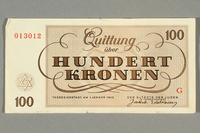
Theresienstadt ghetto-labor camp scrip, 100 kronen note
Object
Scrip, valued at 100 (ein hundert) kronen, of the type distributed in Theresienstadt (Terezin) ghetto-labor camp beginning in May 1943. The ghetto currency was printed by the National Bank in 7 denominations: 1, 2, 5, 10, 20, 50, 100. Inmates were not allowed to have currency, which was confiscated. The SS ordered the Jewish Council to design scrip for use only in the camp, where it was issued to create a false appearance of normalcy. There was little to obtain with the scrip. Located thirty miles northwest of Prague in German occupied Czechoslovakia, the camp was established by the Germans in November 24, 1941, and ceased operation in early May 1945. In 3.5 years, approximately 140,000 Jewish persons were transferred to Terezin; nearly 90,000 were then deported, likely to their death, further east. About 33,000 died in Theresienstadt.
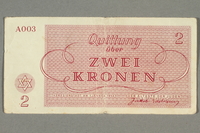
Theresienstadt ghetto-labor camp scrip, 2 kronen note
Object
Scrip, valued at 2 (zwei) kronen, of the type distributed in Theresienstadt (Terezin) ghetto-labor camp beginning in May 1943. The ghetto currency was printed by the National Bank in 7 denominations: 1, 2, 5, 10, 20, 50, 100. Inmates were not allowed to have currency, which was confiscated. The SS ordered the Jewish Council to design scrip for use only in the camp. It was issued to create a false appearance of normalcy. There was little to obtain with the scrip. Located thirty miles northwest of Prague in German occupied Czechoslovakia, the camp was established by the Germans in November 24, 1941, and ceased operation in early May 1945. In 3.5 years, approximately 140,000 Jewish persons were transferred to Terezin; nearly 90,000 were then deported, likely to their death, further east. About 33,000 died in Theresienstadt.
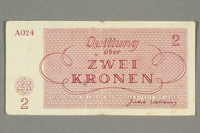
Theresienstadt ghetto-labor camp scrip, 2 kronen note
Object
Scrip, valued at 2 (zwei) kronen, of the type distributed in Theresienstadt (Terezin) ghetto-labor camp beginning in May 1943. The ghetto currency was printed by the National Bank in 7 denominations: 1, 2, 5, 10, 20, 50, 100. Inmates were not allowed to have currency, which was confiscated. The SS ordered the Jewish Council to design scrip for use only in the camp. It was issued to create a false appearance of normalcy. There was little to obtain with the scrip. Located thirty miles northwest of Prague in German occupied Czechoslovakia, the camp was established by the Germans in November 24, 1941, and ceased operation in early May 1945. In 3.5 years, approximately 140,000 Jewish persons were transferred to Terezin; nearly 90,000 were then deported, likely to their death, further east. About 33,000 died in Theresienstadt.

